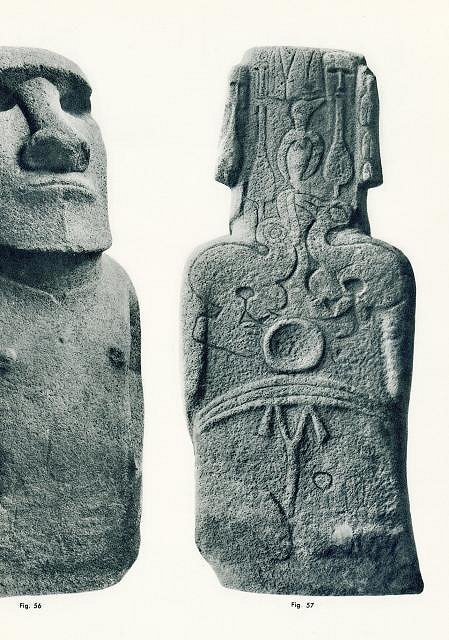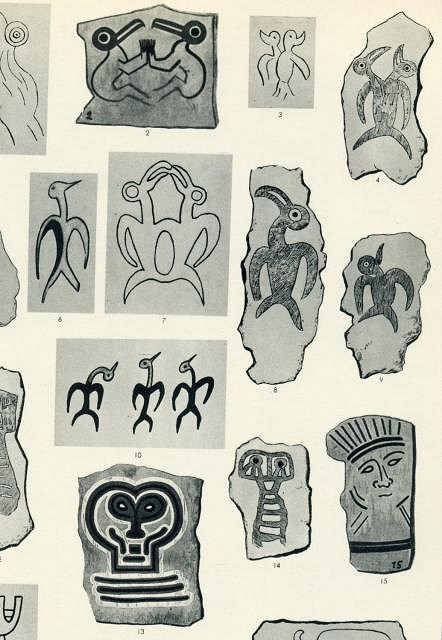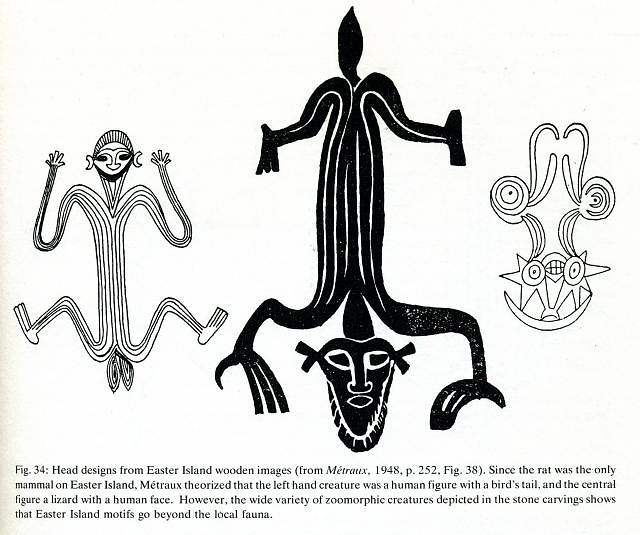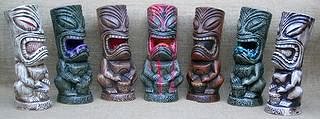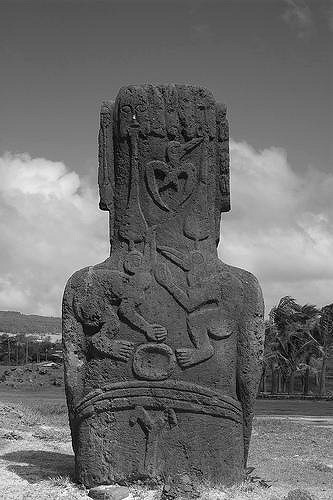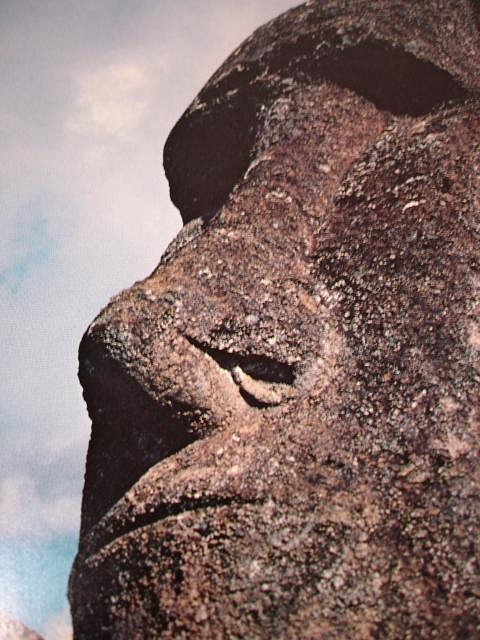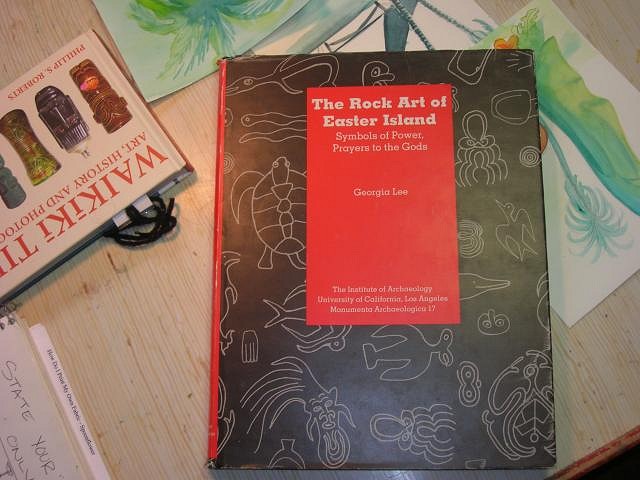Pages: 1 16 replies
|
RH
Robb Hamel
Posted
posted
on
Wed, Oct 6, 2010 4:56 PM
Fellow TCers - you gentle, wise, knowledgeable, and all-around attractive individuals - could you give me advice on where to find graphic information on the following: Polynesian canoes - especially the big, long-distance expedition ones (they're kind of the ancient equivalent of interplanetary spacecraft, huh?). Moai markings - I'm impressed with how hard this is to find. I have Aku Aku, but I'm aware that there is much more detail to those somber monoliths than what is normally depicted, things I've only seen written fragments of. The architecture of Rapa Nui - I keep hearing about ancient stone chicken coups, tombs, crematoriums, a solar observatory, cylindrical towers, a huge terraced ruin on the inside of Rano Kau, and much more. I've asked this before, kinda, but haven't seen the type of drawn reconstructions I'd expect - especially of their unique huts and how they where configured in family groups around the Moai. I'm looking for reference info for future artwork by myself as well as deeping my knowlege of the subject. Thanks for any advice you give, or even the name of archaeologists involved in this kind of thing. Robb Off the ropes and ready to fight. [ Edited by: Robb Hamel 2010-10-12 05:58 ] |
|
T

tikicoma
Posted
posted
on
Wed, Oct 6, 2010 8:55 PM
wow my first post! have you google'd hokule'a images yet? |
|
B
bigbrotiki
Posted
posted
on
Wed, Oct 6, 2010 10:11 PM
You know, I think you're right, there isn't much out there. I pulled out Thor heyerdahl's huge "The Art of Easter Island" when I saw your post, and was disappointed by what I found re your specific requests. This guy in the British museum had the coolest markings:
In terms of designs, you could maybe use petroglyphs:
|
|
S

swizzle
Posted
posted
on
Wed, Oct 6, 2010 10:38 PM
Not long after I got involved in Tiki culture I found a book on sale at Borders imaginatively called 'Easter Island'. It is written by Carlos Mordo and was released by Firefly Books in 2002. Unfortunately I don't have a scanner but after reading your post i've had a quick flick through it and it does have some very good colour photos of some of the things you mentioned. It's a very good book actually and definitely worth tracking down.
[ Edited by: swizzle 2010-10-06 22:40 ] |
|
PR
Phillip Roberts
Posted
posted
on
Wed, Oct 6, 2010 11:04 PM
I have recently bought a few very large books that I love, and you will like. "Vaka Moana: Voyages of the Ancestors. The discovery and settlement of the Pacific." University of Hawaii Press-2007. Edited by K.R. Howe. "The Hawaiian Canoe" Editions Limited 2nd edition 1993 by Tommy Holmes. These are both large volumes and while hard to find, quite worth the effort to do so.
Sven has already pointed you toward Heyerdahl's two volume set. It is quite good.
There is not really a book on this subject yet, and I suspect there will not be soon. There is very little information about these structures due to their few numbers. Remember Rapa Nui is quite tiny. Good luck. |
|
J
JONPAUL
Posted
posted
on
Thu, Oct 7, 2010 1:45 AM
Heyerdahl’s The Art of Easter Island is a single volume. 1961’s Archaeology of Easter Island is the two volume set by Heyerdahl and Edwin Ferdon, Jr. The most up-to-the-minute research on Rapa Nui can be found through Jo Anne Van Tilburg’s Easter Island Statue Project In-depth, archeological studies of the island include: Easter Island: Archaeology, Ecology and Culture by Jo Anne Van Tilburg The Complete Guide to Easter Island by Shawn McLaughlin Easter Island, Earth Island by Paul Bahn and John Flenley As far as online research goes, check this out for some discussion and images of stone structures. Moai back symbols have been discussed here There are some interesting images of Oceania Canoes here And, check out the Polynesian Voyaging Society’s site for a TON of interesting information, including several galleries dedicated to images of Hokulea here |
|
BB
Bongo Bungalow
Posted
posted
on
Thu, Oct 7, 2010 2:59 AM
"you gentle, wise, knowledgeable, and all-around attractive individuals" So right, but how did you know? :wink: |
|
V

virani
Posted
posted
on
Thu, Oct 7, 2010 3:44 AM
I have a couple of books in french by Francis Mazière that has a few pictures of Rapa Nui architecture, and Moai drawings... : "Orongo" (story of a Pascuan kid), and "Fantastique île de Pâques". |
|
RH
Robb Hamel
Posted
posted
on
Mon, Oct 11, 2010 6:44 PM
tikicoma - I've started researching hokule'a - thanks so much for the advice. bigbrotiki - major thanks for including the pics! The British museum character is very interesting, if the regular moai had his markings or his rumored red and black paint job, that would be pretty mind-blowing. I personally think the moai had MANY petroglyphs, especially on their backs. swizzle - thank you very much, I'll search for that book on abebooks!! Phillip Roberts - wow, you must have an incredible library! Those two books sound fantastic! Thanks for responding. JONPAUL - HUGE THANKS for book suggestion AND links!! The stone structure link is PHENOMENAL! And this can't be real...
...without all the mold and weathering, can it?? I'll have to ask Uncle Trav. Bongo Bungalow - just a touch of ESP, I guess. Virani - those two books I'd NEVER have found without your suggestion! Thanks very much, I'll look into them. THANKS EVERYONE SO, SO MUCH FOR TAKING THE TIME TO SHARE YOUR KNOWLEDGE. |
|
RH
Robb Hamel
Posted
posted
on
Mon, Oct 11, 2010 7:18 PM
Here are some observations/questions: Many moai had rope sashes around their waists, but I've noticed the clearly carved line around the base of moai's necks and think it is the neck of a TUNIC that the sash around the waist secures. I believe the moai are meant to be clothed. Is that the consensus? I've read that 2 or 3 moais are female but have never seen a pic of one that looks distinctly feminine. How're these different? I've seen pics of miniature moai hand-carved by Rapa Nui artists that are made of the same volcanic tuff as the real ones, both the yellow figure and red topnot. Are these available somewhere? I never see the curled-nostril detail of moai included in artwork. It does look kinda dorky:
Off the ropes and ready to fight. [ Edited by: Robb Hamel 2010-10-11 20:03 ] |
|
S
Sophista-tiki
Posted
posted
on
Fri, Oct 29, 2010 8:04 PM
bump |
|
S
Sophista-tiki
Posted
posted
on
Sun, Oct 31, 2010 9:18 AM
This bookk is great. it has lots of detailed illustrations and explanations with color pics of caves and dwellings
|
|
B

Babalu
Posted
posted
on
Sun, Oct 31, 2010 10:14 AM
Oops - premature post Have to go back to my library for something back soon [ Edited by: Babalu 2010-10-31 10:16 ] |
|
TR
Tiki Royale
Posted
posted
on
Mon, Nov 1, 2010 9:39 AM
Robb, |
|
PR
Phillip Roberts
Posted
posted
on
Mon, Nov 1, 2010 2:21 PM
Aloha, I'd forgot two really important ones to look at. "Ingrained Images; wood carvings from easter island." by Joan Seaver Kurze, PHD. "Ethnology of Easter Island" by Alfred Metraux Bishop museum Bulletin 160. Reprint 1971. Page 194- Thatched Houses... Ancient Easter Island hen houses (hare moa) were rectangular heaps of stones with a long, narrow, chamber reached by two long narrow passages. Anyone intending to steal had to remove the stones and consequently make a noise the would attract the owners. The book goes on to describe baslat blocks, sizes and how constructed... No diagrams in this part though there are good ones later. Legends, chants, etc... |
|
C
christiki295
Posted
posted
on
Mon, Nov 1, 2010 3:42 PM
I do not think that the Moai were meant to be clothed, unless for a unique ceremony. Also, a sash around the waist seems odd as the moai do not have legs. The Moai did sit upon an Ahu, however. The most important feature were the eyes, made from obsidian, which is were the mana was projected. Don't know about female moai. |
|
UT
uncle trav
Posted
posted
on
Wed, Nov 3, 2010 7:58 AM
JONPAUL - HUGE THANKS for book suggestion AND links!! The stone structure link is PHENOMENAL! And this can't be real...
...without all the mold and weathering, can it?? I'll have to ask Uncle Trav. It's a real image, just can't remember where I got it from at the moment. The reason for the carving looking so "crisp" may be that the Bird Man cult was a later religion on the island. Post ancestor worship and statue carving. The moai may have been carved much earlier than the new images applied to it's back by a long period of time giving it a much more "crisp" look. What a better canvas for your new religion than over the images of the old. This has happened throughout history. Being carved on a vertical surface they may have weathered better that the Bird Man petroglyphs at Orango on the crater rim of Rano Kau. I'm no expert on the subject so if I am on the wrong track of thinking I am sure someone can help you out. Thanks "Anyone who has ever seen them is thereafter haunted as if by a feverish dream" Karl Woermann [ Edited by: uncle trav 2010-11-03 07:59 ] |
Pages: 1 16 replies

